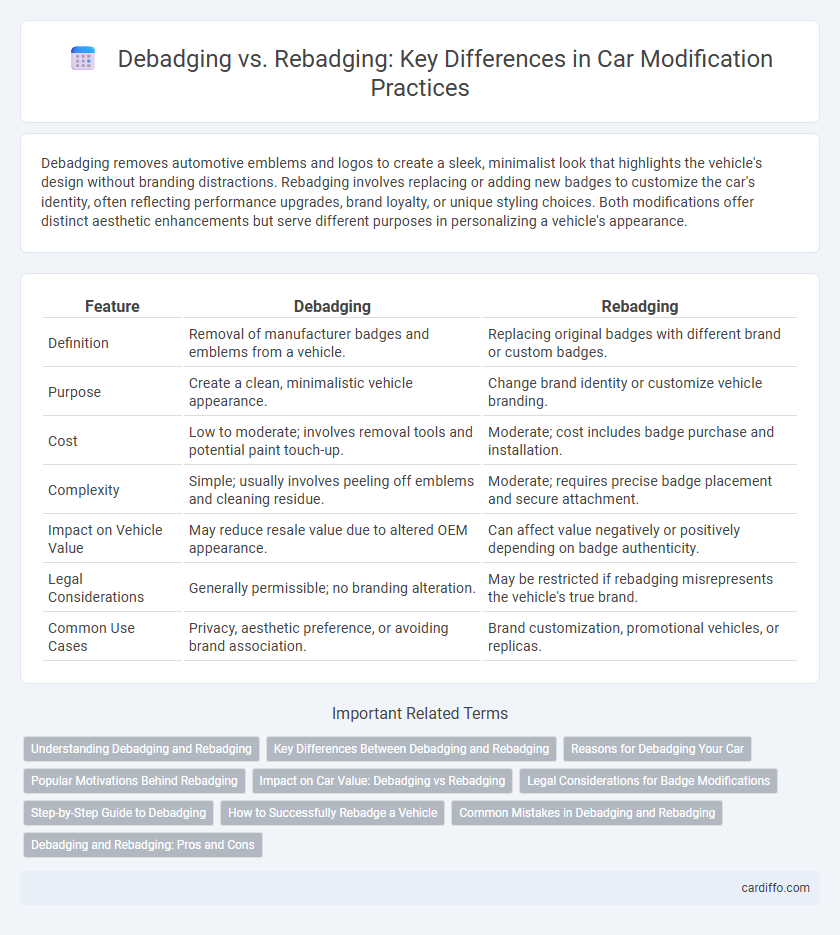Debadging removes automotive emblems and logos to create a sleek, minimalist look that highlights the vehicle's design without branding distractions. Rebadging involves replacing or adding new badges to customize the car's identity, often reflecting performance upgrades, brand loyalty, or unique styling choices. Both modifications offer distinct aesthetic enhancements but serve different purposes in personalizing a vehicle's appearance.
Table of Comparison
| Feature | Debadging | Rebadging |
|---|---|---|
| Definition | Removal of manufacturer badges and emblems from a vehicle. | Replacing original badges with different brand or custom badges. |
| Purpose | Create a clean, minimalistic vehicle appearance. | Change brand identity or customize vehicle branding. |
| Cost | Low to moderate; involves removal tools and potential paint touch-up. | Moderate; cost includes badge purchase and installation. |
| Complexity | Simple; usually involves peeling off emblems and cleaning residue. | Moderate; requires precise badge placement and secure attachment. |
| Impact on Vehicle Value | May reduce resale value due to altered OEM appearance. | Can affect value negatively or positively depending on badge authenticity. |
| Legal Considerations | Generally permissible; no branding alteration. | May be restricted if rebadging misrepresents the vehicle's true brand. |
| Common Use Cases | Privacy, aesthetic preference, or avoiding brand association. | Brand customization, promotional vehicles, or replicas. |
Understanding Debadging and Rebadging
Debadging involves removing manufacturer logos and emblems from a vehicle to create a cleaner, more minimalist appearance. Rebadging replaces these original badges with different ones, often to signify customization, brand affiliation changes, or improved aesthetics. Both modifications alter the vehicle's visual identity but serve distinct purposes in automotive customization and branding.
Key Differences Between Debadging and Rebadging
Debadging involves removing all manufacturer logos and emblems from a vehicle, creating a cleaner, minimalist look that appeals to enthusiasts seeking subtle customization. Rebadging replaces the original badges with alternative ones, often changing the brand or model identity to reflect upgrades, special editions, or personalize the vehicle's appearance. Key differences include debadging's emphasis on removal for understated aesthetics, whereas rebadging focuses on replacement for branding or stylistic enhancement.
Reasons for Debadging Your Car
Removing badges from a car eliminates manufacturer logos and model identifiers, enhancing its sleek and minimalist appearance. Debadging can also prevent theft or vandalism by making the vehicle less recognizable and reducing targeted damage. Some owners debadge to express personal customization, creating a unique look that differentiates their car from stock versions.
Popular Motivations Behind Rebadging
Rebadging is primarily driven by manufacturers seeking to expand brand reach and penetrate new markets without the costs of developing entirely new models. This practice leverages existing vehicle platforms to maximize economies of scale and streamline production processes. Consumer demand for variety and brand loyalty also motivates automakers to introduce rebadged vehicles tailored to specific regional preferences.
Impact on Car Value: Debadging vs Rebadging
Debadging typically maintains or slightly increases car value by appealing to buyers seeking a clean, minimalist look without altering the vehicle's identity. Rebadging can impact car value variably, often decreasing it if perceived as a misleading modification, but it may add value in niche markets where rare badges or custom emblems are desired. Understanding market preferences and the authenticity of branding is crucial for maximizing the impact on car resale value in both debadging and rebadging scenarios.
Legal Considerations for Badge Modifications
Debadging a vehicle typically involves removing manufacturer logos without altering registration details, which is generally legal but may vary by jurisdiction. Rebadging, involving replacing original badges with aftermarket or different manufacturer emblems, can lead to legal issues such as misrepresentation or trademark infringement if not disclosed properly. Vehicle owners should consult local laws and regulations to ensure compliance, especially regarding identification standards and resale transparency.
Step-by-Step Guide to Debadging
Debadging involves carefully removing vehicle emblems and badges without damaging the paint, starting with softening the adhesive using heat from a hairdryer or heat gun. Use dental floss or fishing line to gently slide behind the badge to detach it, then clean residual glue with adhesive remover for a smooth surface. This process enhances the car's minimalist look and preserves resale value by avoiding permanent alterations.
How to Successfully Rebadge a Vehicle
Successfully rebadging a vehicle requires careful removal of the original badges using heat guns or plastic prying tools to avoid damaging the paintwork. Precise surface cleaning with alcohol ensures optimal adhesion before applying new emblems that match the vehicle's make or customized branding. Proper alignment and pressure during installation guarantee a seamless, professional appearance while preserving the car's resale value.
Common Mistakes in Debadging and Rebadging
Common mistakes in debadging include using excessive force that damages the paint or leaving adhesive residue that attracts dirt and corrosion. In rebadging, errors often involve misalignment of badges and using incorrect or low-quality emblems, which can reduce the vehicle's aesthetic and resale value. Both processes require careful preparation and proper tools to avoid costly repairs and ensure a professional finish.
Debadging and Rebadging: Pros and Cons
Debadging enhances a vehicle's sleek appearance by removing manufacturer logos, which can improve resale value and reduce theft risk but may decrease brand recognition. Rebadging involves replacing original badges with aftermarket or different brand emblems, offering customization and potential performance perception while risking warranty issues and confusing consumers. Both modifications impact vehicle identity and market perception, with debadging favoring subtlety and rebadging targeting personalization.
Debadging vs Rebadging Infographic

 cardiffo.com
cardiffo.com